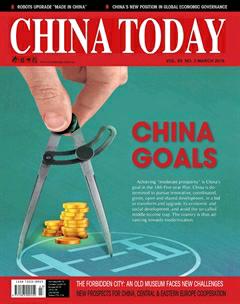Conference and Exhibition Industry Boosts Qiqihar’s Development
By XU YING
Conference and Exhibition Industry Boosts Qiqihar’s Development
By XU YING
A few cities across China’s vast land have a long history, rich culture and picturesque sights. Qiqihar, also known as “the city of cranes,” is just one of the many. Nurtured in the northeastern province of Heilongjiang, it is renowned for its strategic position and confluence of diverse cultures. Looking back over recent years, the booming convention and exhibition industry has also infused energy into this city.

Qiqihar International Convention and Exhibition Center.
A Sunrise Industry
The convention and exhibition industry first emerged in China at the end of the 20th century, and experienced rapid development thereafter. Since China joined the World Trade Organization (WTO) in 2001, in particular, this industry has encountered greater opportunities, and become vibrant among China’s first-tier cities, its outstanding performance drawing world attention. The convention and exhibition industry is consequently called a “sunrise industry” for being free of resource consumption and offering a bright future.
It is no accident that the convention and exhibition industry is booming in China. Statistics show that internationally the industry generates revenues 10 times its own business returns. In other words, every yuan a conference/exhibition makes will bring in 10 yuan to such related industries as hospitality, catering, transport, telecommunications, tourism, and trade. In China, the ratio holds at 1:9, according to investigations carried out in Shanghai and Shenzhen. Conferences and exhibitions are able to attract a large number of exhibitors and visitors, both local and foreign, stimulat-ing related businesses such as restaurants, transportation, logistics, telecommunications, and even environmental protection. All these factors contribute to the host city’s comprehensive economic development.
In addition, this sunrise industry uplifts a city’s image, and promotes its visibility across the nation and even the world. It is widely accepted that a key measure of a city’s international influence is aligned with the number and scale of international conferences and exhibitions the city hosts. From this perspective, international conferences and exhibitions are a special calling card, as they signify a city’s scientific and technological level, and economic strength. Moreover, conferences and exhibitions also provide opportunities to promote a city’s culture and sights to exhibitors, visitors, and traders. So it is easy to understand why the convention and exhibition industry can enhance a shared understanding among governments, organizations and business circles, as well as tourism, cultural and people-topeople exchanges.
A Boost for Qiqihar
In recent years, as local governments become aware of the benefits of hosting conferences and exhibitions, more and more cities look to the industry to highlight their particular distinctions. In 2006, Qiqihar constructed its International Convention and Exhibition Center. Since then, the concept of a conference and exhibition economy has gained gradual local acceptance.
In April 2011, the Qiqihar Hecheng International Convention and Exhibition Co., Ltd. was established, focusing on the convention and exhibition industry and also expanding new vistas for Qiqihar’s economic development. The company now hosts two important exhibitions – the China Green Food Expo and the China Small Commodity Trading Fair – in addition to large-scale exhibitions in the auto, real estate and home décor sectors.
From three exhibitions in 2006 to 16 in 2012, Qiqihar has accumulated rich experience in the exhibition industry, which plays a leading role in local economy. Through attracting investment and building corporate cultures, exhibitions and conferences have made a great contribution to the city’s economic and cultural development.

The Qiqihar Auto Industry Expo.
A Continuous Force
Against the backdrop of the Chinese government advocating frugality, alongside downward pressure on economy in the last few years, China’s convention and exhibition industry has felt the pinch. Yet many doubt the industry is stepping into its winter.
At the 11th China International Events Festival in Hainan Province in August, 2015, participating experts were optimistic about the future. “I think this is the best time for China to develop the convention and exhibition economy,” said Wei Jianguo, deputy director general of the China Center for International Economic Exchange and former vice minister of commerce.“Conferences and exhibitions should become venues where a country or even the world can seek solutions for economic development. They should be considered a part of a city or a nation’s soft power. Conferences and exhibitions are not only a section of the service trade industry, but also a platform on which regional culture and characteristics are promoted.” Wei added, “Conferences and exhibitions should play the role of barometer for an industry, to enable participating exhibitors and visitors to learn about the world’s most advanced products and technologies. Enterprises can then perceive industrial trends and accordingly make their plans.”
In fact, after a brief adjustment in 2014, the domestic exhibition industry has again achieved rapid growth. Statistics from the China Council for the Promotion of International Trade reveal that in 2015 there were 3,168 exhibitions and conventions held in China, spanning a total area of 89 million square meters. Among them, economic and trade exhibitions added up to 2,612, covering about 78.74 million square meters, a 7.8 percent and 10.8 percent increase respectively over the previous year. This implies faster growth than that of such leading countries as the United States and Germany.
With regard to the sector’s future, Wang Zhiping, director of the China Foreign Trade Center, said that as China is further deepening reforms in all aspects, continuous reform in the convention and exhibition industry should improve the market by reducing chaotic and predatory competition. In addition, traditional industries have accelerated integration with emerging industries. Seizing the opportunities of China’s “Internet Plus”strategy, many companies are further integrating resources and expanding the industrial chain, laying a solid foundation for future development of the convention and exhibition industry.
Furthermore, China has put forward a slew of initiatives and action plans, including the Belt and Road Initiative, an increase in free trade areas, Made in China 2025, innovation-driven development, and “Internet Plus,” all of which signal profound changes to and reform of the existing patterns in the convention and exhibition industry.
“It is foreseeable that industrial restructuring and integration with other industries will tap the potential of the market, and benefit China’s convention and exhibition industry,” Wang said. So it is expected that the industry will continue to boost the development of Qiqihar.C

